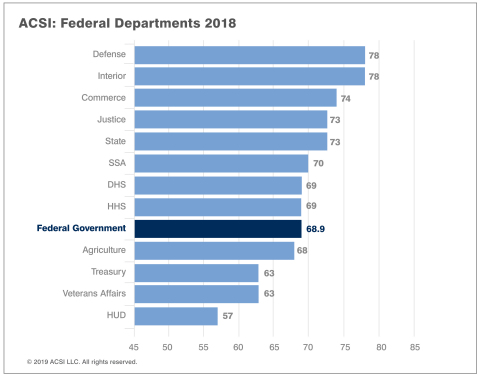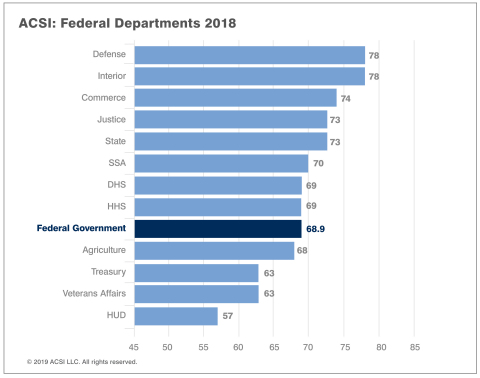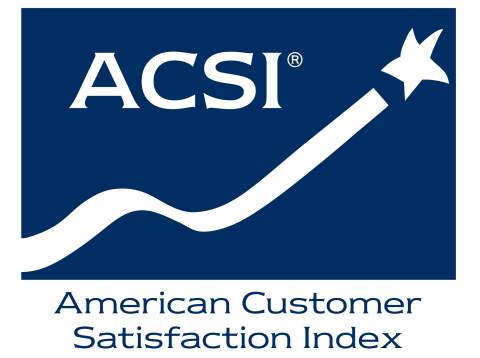ANN ARBOR, Mich.--(BUSINESS WIRE)--Following two straight years of progress, citizen satisfaction with the U.S. federal government takes a slight dip in 2018.
Overall, satisfaction decreases 1.1 percent to a score of 68.9 on a scale of 0 to 100 according to the American Customer Satisfaction Index (ACSI®) 2018 Federal Government Report. Yet, even with the minor drop-off, satisfaction sits at its second-highest mark since 2008.
“While this data was collected prior to the start of the government shutdown, this overall decline couldn’t have come at a worse time,” says Forrest Morgeson, Director of Research and Global CSI Manager at the ACSI. “In all likelihood, the shutdown will exacerbate Americans’ declining satisfaction with the federal government in 2019.”
Four key drivers of citizen satisfaction each take a hit
The ACSI federal government model consists of four key drivers of citizen satisfaction: process, information, customer service, and website. Each declines in the latest ACSI report.
The federal government’s quality of information and customer service drop to their lowest marks since 2015, with the former declining 2.7 percent year over year to 71 and the latter falling 1.3 percent to 76. Meanwhile, the timeliness and ease of government processes and the usefulness of government websites falter to their 2016 levels, with ACSI scores of 70 and 76 respectively.
The decline of all four drivers indicates that no one aspect of federal government services is responsible for waning citizen satisfaction in 2018.
Departments of Defense and Interior receive high marks; HUD not so much
Citizen satisfaction varies widely across departments within the federal government. This makes sense, as many of these departments provide benefits or low-cost/free services that citizens want, while other departments offer services that citizens would rather do without.
The Departments of Defense and the Interior hold the highest customer satisfaction scores at 78. The Department of Commerce is next with an ACSI score of 74, just ahead of the Justice and State Departments, each at 73. These marks sit above the federal government-wide average of 68.9 and are comparable to many private-sector services.
At the other end of the spectrum sits the Department of Housing and Urban Development (HUD) with a 57, the lowest score among federal departments. With the exception of a few subscription TV and internet service providers, HUD scores worse than all 380+ companies measured in the ACSI.
“This is hardly surprising,” says Morgeson. “Managing low-income housing loans is a sensitive and highly charged experience.”
The Departments of Agriculture (68), Treasury (63), and Veterans Affairs (63) all score higher than HUD, yet still fall short of the federal government-wide score.
Pension Benefit Guaranty Corporation and Bureau of Consular Affairs lead all federal agencies
Citizen satisfaction also varies significantly across the different federal agencies within departments. The Pension Benefit Guaranty Corporation (PBGC) receives a top-level score of 89 from retirees. The Bureau of Consular Affairs (BCA) is also a satisfaction leader, scoring 89 for its call center.
On the flip side, agencies within the Treasury Department rank among the lowest. Specifically, most Internal Revenue Service (IRS) programs score in the low-to-mid 60s, with individual paper filers rating the IRS at 61, while large business and international filers give the lowest rating, with a 60. In contrast, individual e-filers are much happier (76).
Politics play a less-than-surprising role in citizen satisfaction
Although the ACSI doesn’t measure citizen satisfaction with specific individuals or political parties, political affiliations inevitably influence citizen satisfaction with government services.
Democrats and Republicans had similar levels of customer satisfaction between 2016 and 2017 as the federal government transitioned from the Obama to the Trump Administration. Those scores shifted in 2018.
While citizen satisfaction increased among Republicans, up 2.9 percent to 71, and Independents, up 1.5 percent to 68, the dissatisfaction among Democrats and those who identify as “Other Party” drops at an even larger rate. Democrats’ satisfaction declines 5.5 percent to 69 and satisfaction among individuals in the “Other Party” category plummets 9.2 percent to an ACSI score of 59.
The ACSI Federal Government Report 2018 is based on interviews with 2,779 users, chosen at random and contacted via email throughout the year. ACSI scores for individual agencies are derived from independent research conducted by CFI Group, which licenses the ACSI methodology. Download the full Federal Government Report.
Follow the ACSI on LinkedIn and Twitter at @theACSI.
No advertising or other promotional use can be made of the data and information in this release without the express prior written consent of ACSI LLC.
About ACSI
The American Customer Satisfaction Index (ACSI®) has been a national economic indicator for 25 years. It measures and analyzes customer satisfaction with more than 380 companies in 46 industries and 10 economic sectors, including various services of federal and local government agencies. Reported on a scale of 0 to 100, ACSI scores are based on data from interviews with roughly 250,000 customers annually. For more information, visit www.theacsi.org.
ACSI and its logo are Registered Marks of the University of Michigan, licensed worldwide exclusively to American Customer Satisfaction Index LLC with the right to sublicense.




